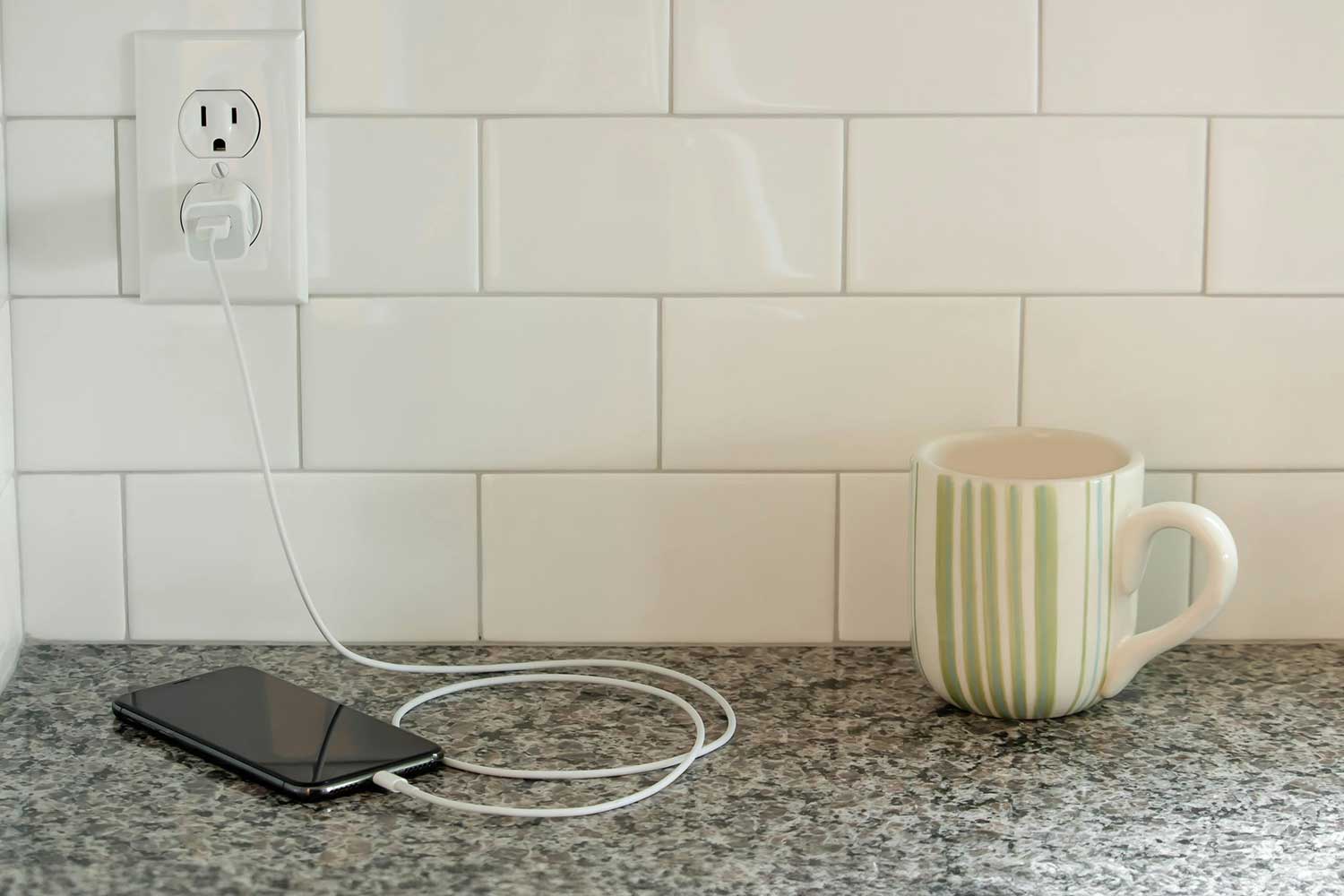Hey team, and welcome back to one5c! If it seems like we’ve had gadgets on the brain lately, that’s because we have. Apple dropped the newest iPhone last week, sending the tech reviewers of smartphones past in the room (🙋♀️) swirling back into old oooh shiny habits. But we’ve also been digging deep into the world of device repair and refurbishment. Why? Because there are already a lot of better-than-serviceable phones in the world, and the churn of the upgrade cycle is taking a planetary toll. It’s like this: If we all kept our phones 18 months longer, the cumulative impact is the same as taking more than 700,000 cars off the road.
Thinking about device longevity was actually the focus of our event at Climate Week in New York City a few days back, but we wouldn’t be us if we didn’t also dole out what y’all need to know to put it into practice. Matt’s got 7 great tips for hanging on to that handset as long as you can. —Corinne
SPONSOR

HOW TO EXTEND THE LIFE OF YOUR SMARTPHONE
By Matt Berical

With the arrival of any new smartphone generation—be it the iPhone 16 or the Google Pixel 9—comes the perennial urge to upgrade. It’s a bug that catches more of us than you might think: According to a report by Consumer Affairs, about 55% of cellphone users upgrade their device every two or three years, around 12% of Americans spring for a replacement annually, and some 4.3% buy a new phone every six months.
The fanfare that comes with new designs, faster processors, tougher screens, and enhanced cameras, however, also has an environmental toll—at both the beginning and end of a new device’s life. It takes around 250 pounds of raw materials to make a single device, the vast majority of the lifetime emissions of a handset happen during production, and e-waste is the single fastest growing trash stream in the world, representing more than 68 million tons in 2022.
Yes, there are buyback programs, marketplaces to buy and sell refurbished tech, and recycling initiatives to make getting rid of an old phone less environmentally deleterious. But even with all that, one of the absolute best things you can do to keep your device out of the waste stream for as long as possible is to…keep it as long as possible.
Doing that comes down to practicing proper care like good charging habits, regular maintenance, and updating to the latest software—which is a necessity for keeping your phone secure. Samsung and Google will send updates for seven years, and Apple will push ‘em for five. Here’s how you can keep your smartphone going just as long.
1. Adopt good charging habits
If your phone doesn’t hold a charge for very long, you’re basically carrying around an expensive paperweight. Optimizing battery health is one of the most critical ways to increase longevity, says Michael Collins, a technology consultant and the CEO of SphereIT, a London-based IT support company. “The point is not to make your battery totally discharged and then charge again,” he says. That means holding a level between 20% and 80%. The reason comes down to battery chemistry: Regularly using up all the capacity in lithium-ion cells speeds up the aging of the battery. “Extremes wear chemically faster,” he says.
Developers have baked some protocols to help out here. Starting with the release of iOS 13 in 2019, for instance, iPhones have had an “Optimized Battery Charging” setting that holds the level below 80% when the handset predicts you’ll have it plugged in for a long time—like when you go to bed. Last year, Apple gave users the option to select an 80% limit at all times. There are also adaptive charging options to help cap capacity on Android devices.
2. Install those software updates
Anytime you receive an operating system update from your manufacturer, you should install it as soon as possible. These software pushes often include new security measures to help keep users safer from hackers and other malevolent online forces but also, Collins says, offer patches and different forms of optimizations that keep your device running smoothly. Neglecting updates for an extended period can lead to system failures and the loss of data.
3. Mind your apps (and storage)
Chances are your phone is cluttered with apps you never use. While you may want to be the type of person who taps that meditation app, holding on to a heap of old programs may slow your device. “A congested phone noticeably hampers the performance,” says Collins. He recommends clearing your phone’s data cache at least every couple of months and wiping any apps you haven’t touched in more than three months. (It’s also a good habit to transfer photos and videos to cloud storage or an external drive every few months.)
Devices do have built-in functions to assist with this. When turned on in settings, Apple’s “Offload Unused App” function removes anything you haven’t used for 12 days or more but retains related documents and data. If you want to use an app that’s been offloaded, you can simply redownload it. Android devices have a similar feature. In both platforms, you can also manually delete apps via the storage menu.
4. Use a case
An obvious but important step: Get yourself a high-quality case (and maybe also a screen protector) to defend your phone against everything from big falls to being submerged in a big pot of chili (it can happen). “These can help prevent physical damage that could involve costly repairs or another phone altogether,” says Collins. The specific case you choose depends on your occupation and level of klutziness. But, at the very least, you want to cover up the corners, edges, and back of the phone.
5. Watch out for extremes
If you’ve ever left your device out in the sun for a long time, you’ve likely seen a message that reads: “iPhone needs to cool down before you can use it” or “device cooling down.” This built-in fail-safe prevents damage, as high temperatures can harm the phone’s battery and other internal components. “Heat corrosively affects the battery’s electrochemical active material,” says Collins. “For instance, if your phone is left in a car on a hot day, it increases the risk of battery chemical reactions, which could cause loss of battery capacity.” It’s a good habit, then, to avoid extremely high or low temperatures or at least keep your phone in a cool, shady spot when the mercury’s high, or a warm, insulated area when it drops.
6. Maintain a cleaning schedule
Dirt, dust, and pocket lint can easily sneak into ports. This can affect the sound of your phone, limit the functionality of the buttons, and harm the connection between your device and its power cord. “The best way of making sure a phone lasts longer than its stipulated life span is by regular cleaning,” says Collins. Standard practice is to sanitize your phone’s surface with an alcohol-based disinfectant, and use a toothpick or microtool from an electronic cleaning kit to carefully dislodge any debris from the ports or corners of the buttons every few weeks.
7. Repair whenever you can
Nothing lasts forever, which is especially true of phone screens and batteries—the most commonly busted parts of a handset. We’ve all likely endured the self-inflicted humiliation of a cracked screen, and Collins says that even with the best charging practices, lithium-ion power packs will eventually show their age.
Neither means you need to run to the store. Cracked screens and withering batteries can be repaired, and myriad options exist. Apple, Samsung, and Google might cover the repair under a warranty or extended care plan. Even without coverage, you can pay for repairs at a retailer like the Apple Store, or a reliable, third-party repair shop like one associated with Assurant’s Cell Phone Repair. If you’re feeling DIY-y, the internet is also your friend here: iFixit maintains a robust catalog of repair manuals and how-tos and also sells the parts and tools to repair the damage yourself.
When’s it actually time to let it go?
Realistically, proper care will only get most people so far, and there are telltale signs for when it might be time to let your device go, including, crucially, when it can no longer receive necessary patches and updates, making it more susceptible to hacks. Here are the three biggies.
Matt Berical is a writer and editor based in Richmond, Virginia. Most recently, he was the deputy editor of the parenting site Fatherly for seven years. His work has appeared in GQ, Men’s Journal, Taste, Popular Science, and more.
CLIMATE WEEK RECAP

Quiz: How can consumer tech cool the climate?
On Tuesday during Climate Week, we spent the afternoon chatting with heavy hitters from Back Market, iFixit, Google, WIRED, and more about how we can all help make consumer technology more sustainable. The order of the day? A series of panels and demos that explored the legal, business, and consumer landscape of repaired and refurbished tech.
Suffice it to say, we learned plenty about this growing lower-carbon, less consumption-heavy product ecosystem. For example, did you know that there’s a country that requires companies to indicate how repairable a product is right on the label? Take our quiz to find out who—and also delve into some of our other favorite world-saving nuggets from the day.
THE ROUNDUP
In the news this week
By Olivia Gieger
California is suing ExxonMobil for selling the public on plastic recycling and promoting the use of the chasing arrow symbol on all plastic products, despite knowing it would deceive people into thinking that all those wares are recyclable—even when they’re not. The suit further claims that the company’s promotion of chemical recycling as a healthier, more effective alternative to mechanical recycling is also smoke and mirrors.
The path to triple our renewable output is within reach, according to a new report from the International Energy Agency (IEA), noting that nations need to step up their games to get there. Last December, more than 200 countries signed an agreement to triple renewable energy capacity by 2030 and transition away from fossil fuels. The IEA estimates that doing so would require major attention to electric grids, including modernizing more than 15 million miles of connections in the next 6 years and massively increasing battery storage capacity.
Lawmakers are asking the Federal Housing Finance Agency (FHFA), which oversees the country’s two largest mortgage backers, to implement energy efficiency standards in new homes. Any FHFA mandate would more or less become a de facto national standard. If adopted, the change could save 194 million metric tons of carbon dioxide emissions, the director of the nonprofit American Council for an Energy-Efficient Economy tells Grist.
Amazon, Bayer, H&M, and Walmart are among a group of companies buying $180 million of carbon offset credits in the Amazon rainforest in a collective agreement, Reuters reports. Carbon offset credits are notoriously suspicious, especially tree-growing projects, and the organization behind these ones in particular has been accused of greenwashing in a previous report from Amazon Watch, a nonprofit environmental watchdog group.
President Biden addressed the U.N. General Assembly in New York on Tuesday, and while much of his remarks focused on the long history of conflicts he has encountered in his time as a politician, he took a minute to tout his climate record toward the end. He noted that the U.S. is on track to cut emissions 50% by 2030 and that the administration has invested hundreds of billions into development goals and climate support for developing nations. “I know many look at the world today and see difficulties and react with despair,” he said. “But I do not. I won’t.”
